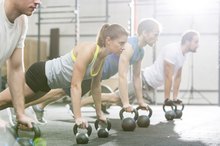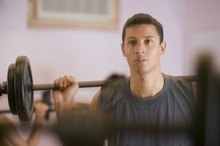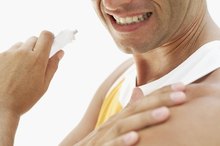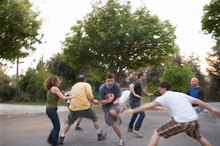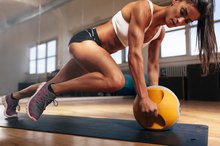Do Protein Shakes Build Muscle in Your Legs?
Regular gym-goers often guzzle protein shakes to augment their rigorous strength-training routine. These shakes usually contain some combination of whey and soy protein, along with carbohydrates and sweeteners. Consuming protein after a workout can help you with recovery, repair and muscle growth, but drinking them without exercising will not build muscle in your body, including your legs.
About Shakes
Protein shakes may be premixed or homemade. They usually provide between 20 and 40 g of protein and promise to help you get a leaner body with bigger muscles. According to the International Society of Sports Nutrition, or ISSN, exercising individuals do need more protein, up to 2 g per kg of body weight daily as opposed to the 0.8 g per kilogram of body weight recommended for sedentary individuals. Protein shakes are a convenient way to fit in some of this extra protein.
- Protein shakes may be premixed or homemade.
- They usually provide between 20 and 40 g of protein and promise to help you get a leaner body with bigger muscles.
Timing
How Much Protein Per Day if Working Out?
Learn More
Protein consists of chains of amino acids. Consuming amino acids around the time of exercise, usually right before and right after, can help support muscle growth. A study in the journal “Amino Acids” published in 2007 found that ingesting 20 g of protein and amino acids an hour before and after exercise can help improve muscle performance, synthesis and growth. Drinking a protein shake before and after a leg workout can help you build leg muscle.
- Protein consists of chains of amino acids.
- A study in the journal “Amino Acids” published in 2007 found that ingesting 20 g of protein and amino acids an hour before and after exercise can help improve muscle performance, synthesis and growth.
Exercise
To build leg muscles, you must perform regular, consistent strength routines with heavy weights. Exercises such as squats, deadlifts, lunges and calf raises target the quadriceps, hamstrings, gluteals and calves to build muscle. You want to use weights that allow you to do 20 or fewer repetitions per set. Without weight training, your muscles are not stimulated to grow stronger no matter how much protein you consume.
- To build leg muscles, you must perform regular, consistent strength routines with heavy weights.
Considerations
Does Whey Protein Powder Build Muscle?
Learn More
You also must leave adequate rest between leg strength-training workouts to experience maximal results. The actual act of lifting causes micro tears in the muscles, and you need rest so these tears repair, making your muscles bigger and stronger. Avoid working legs on consecutive days to allow for proper recovery.
Related Articles
References
- Journal of the International Society of Sports Nutrition: Position Stand: Protein and Exercise
- Men's Fitness: 10 Ways to Gain Muscle
- Amino Acids: Effects of Resistance Training and Protein Plus Amino Acid Supplementation on Muscle Anabolism, Mass, and Strength
- Muscle and Strength: Overtraining -- Why Less Is More
- McColl P. 9 things to know about how the body uses protein to repair muscle tissue. ACE Fitness. Updated March 5, 2018.
- Jäger R, Kerksick CM, Campbell BI, et al. International Society of Sports Nutrition Position Stand: Protein and exercise. J Int Soc Sports Nutr. 2017;14:20. doi:10.1186/s12970-017-0177-8
- Snijders T, Trommelen J, Kouw IWK, Holwerda AM, Verdijk LB, Van Loon LJC. The impact of pre-sleep protein ingestion on the skeletal muscle adaptive response to exercise in humans: An update. Front Nutr. 2019;6:17. doi:10.3389/fnut.2019.00017
- Holwerda AM, Kouw IW, Trommelen J, et al. Physical activity performed in the evening increases the overnight muscle protein synthetic response to presleep protein ingestion in older men. J Nutr. 2016;146(7):1307-14. doi:10.3945/jn.116.230086
- Kouw IW, Holwerda AM, Trommelen J, et al. Protein ingestion before sleep increases overnight muscle protein synthesis rates in healthy older men: A randomized controlled trial. J Nutr. 2017;147(12):2252-2261. doi:10.3945/jn.117.254532
- Trommelen J, Van Loon LJ. Pre-sleep protein ingestion to improve the skeletal muscle adaptive response to exercise training. Nutrients. 2016;8(12). doi:10.3390/nu8120763
- Res PT, Groen B, Pennings B, et al. Protein ingestion before sleep improves postexercise overnight recovery. Med Sci Sports Exerc. 2012;44(8):1560-9. doi:10.1249/MSS.0b013e31824cc363
- Snijders T, Res PT, Smeets JS, et al. Protein ingestion before sleep increases muscle mass and strength gains during prolonged resistance-type exercise training in healthy young men. J Nutr. 2015;145(6):1178-84. doi:10.3945/jn.114.208371
- Sahni S, Mangano KM, Hannan MT, Kiel DP, Mclean RR. Higher protein intake is associated with higher lean mass and quadriceps muscle strength in adult men and women. J Nutr. 2015;145(7):1569-75. doi:10.3945/jn.114.204925
- Robinson MM, Dasari S, Konopka AR, et al. Enhanced Ttranslation underlies improved metabolic and physical adaptations to different exercise training modes in young and old humans. Cell Metab. 2017;25(3):581-592. doi:10.1016/j.cmet.2017.02.009
- Pesta DH, Samuel VT. A high-protein diet for reducing body fat: Mechanisms and possible caveats. Nutr Metab (Lond). 2014;11(1):53. doi:10.1186/1743-7075-11-53
- How many calories are in one gram of fat, carbohydrate, or protein? U.S. Department of Agriculture.
- Pritchett K, Meyer EL Eds. Nutrition, Health and Athletic Performance. MDPI. 2017.
- Deeth HC, Bansal N, Eds. Whey Proteins: From Milk to Medicine. Academic Press. 2019.
- Witard OC, Wardle SL, Macnaughton LS, Hodgson AB, Tipton KD. Protein considerations for optimising skeletal muscle mass in healthy young and older adults. Nutrients. 2016;8(4):181. doi:10.3390/nu8040181
- Miranda JM, Anton X, Redondo-valbuena C, et al. Egg and egg-derived foods: Effects on human health and use as functional foods. Nutrients. 2015;7(1):706-29. doi:10.3390/nu7010706
- Marangoni F, Corsello G, Cricelli C, et al. Role of poultry meat in a balanced diet aimed at maintaining health and wellbeing: An Italian consensus document. Food Nutr Res. 2015;59:27606. doi:10.3402/fnr.v59.27606
- Kerksick CM, Wilborn CD, Roberts MD, et al. ISSN exercise & sports nutrition review update: Research & recommendations. J Int Soc Sports Nutr. 2018;15(1):38. doi:10.1186/s12970-018-0242-y
Writer Bio
Andrea Cespedes is a professionally trained chef who has focused studies in nutrition. With more than 20 years of experience in the fitness industry, she coaches cycling and running and teaches Pilates and yoga. She is an American Council on Exercise-certified personal trainer, RYT-200 and has degrees from Princeton and Columbia University.
